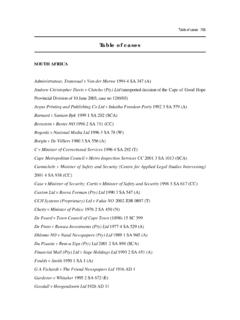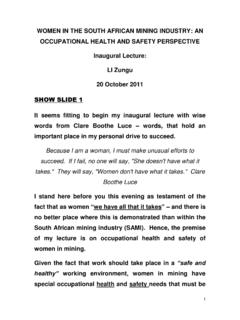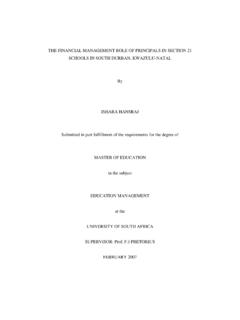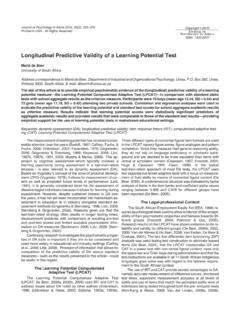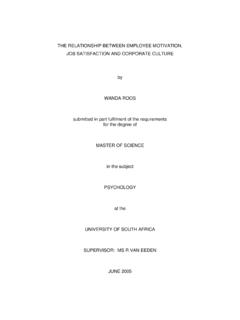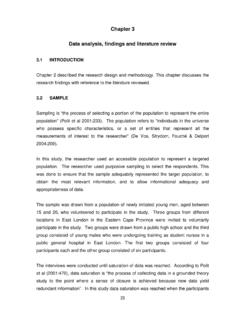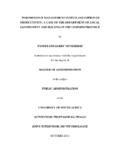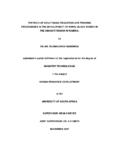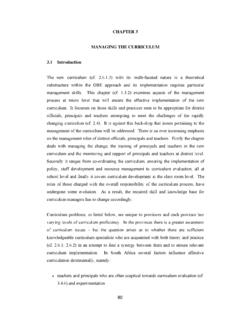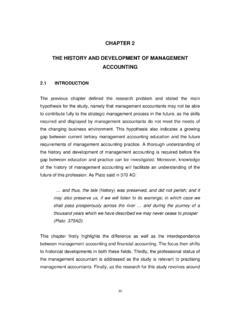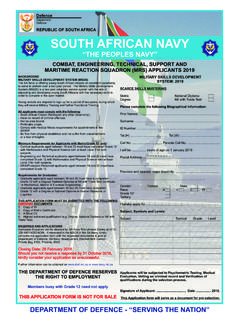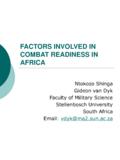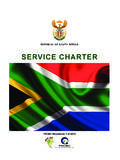Transcription of CHAPTER 6 TOTAL QUALITY MANAGEMENT IN …
1 CHAPTER 6. TOTAL QUALITY MANAGEMENT IN THE south african AIR FORCE. INTRODUCTION. The preceding two chapters provided an extensive review of the literature available on the dimensions of TQM. These dimensions were divided into primary and supportive roles, and were furthermore identified as being part of hard MANAGEMENT necessities and soft . outcomes. The need to have an integrated approach to all 14 dimensions was also clarified. However, the focus of chapters 4 and 5 was on the points of view of scholars and experts as reflected in published sources. In order to introduce the primary part of the research reported in this thesis, it is therefore necessary to turn to practice. This CHAPTER will therefore discuss the SA Air Force and its context as an introduction to the empirical research undertaken for the thesis. Since 1980 it was necessary for the SA Air Force to make continuous adaptations to its administrative and MANAGEMENT systems in order to stay abreast of changing circumstances.
2 In 1998 a decision was made to apply more QUALITY MANAGEMENT techniques in order to increase performance results and productivity. One of the methods followed was the establishment of a formal self-assessment programme based on the model of the EFQM that was launched in August 1998 by the Inspector General of the SA Air Force, followed in January 2002 with the SAEF model. To enable the SA Air Force to determine results and areas for improvement continuously, it became clear that a new approach to MANAGEMENT was needed to guide all MANAGEMENT initiatives based on the TQM philosophy in order to ensure improved performance. The SA Air Force will be able to make a valuable contribution over the next few decades should it institute a TQM. philosophy in its entirety with the aim of focusing the organisation on improvement. The purpose of this CHAPTER is therefore to provide details of the SA Air Force in order to understand the process followed by the organisation in implementing TQM at its various bases.
3 To achieve this, it is first necessary to provide information on the aim, functions and strategic direction of the SA Air Force. Following this, a review is provided of its organisational design and structure before turning to a discussion of the historical development of the implementation on TQM in the SA Air Force since 1980 to the present. Based on the available literature, the TQM methodology utilised in the SA Air Force is reviewed, followed by an examination of the self-assessment methodology (based on the SAEF) that is used by the SA Air Force to improve its overall performance and to promote excellence. The latter includes a review of the role and function of the Directorate MANAGEMENT and Renewal Services and the role and function of the Inspector General in the implementation of self-assessment methodologies. AIM, FUNCTIONS AND STRATEGIC DIRECTION OF THE SA AIR FORCE.
4 The mandate of the SA Air Force is to provide air power1 to the nation and manage the air defence capability of the Department of Defence (hereinafter referred to as DOD) on behalf of the DOD, thereby participating in the service to ensure: (1) the sovereignty and protection of the Republic of south Africa's (hereinafter referred to as RSA) territorial integrity, and (2) compliance with the international obligations of the RSA to international bodies and states. The aim of the SA Air Force is as follows: To help ensure the interests of the Republic of south Africa by means of air operations. The primary function of the SA. Air Force is to obtain and maintain a favourable air situation (Van Zyl 2003:2). To support the primary function of the SA Air Force the secondary functions are as follows (Coetzee 2003:9-10): to participate in land battle.
5 To participate in maritime battle;. to protect SA Air Force assets;. to pose a credible deterrent to external aggression;. to provide a military air transport capability;. to act to preserve life, health and property;. to assist and co-operate with other friendly air forces and institutions;. to assist on short notice with humanitarian aid to south Africa and its neighbouring countries; and to assist and co-operate in peacekeeping operations on the african continent (for example in Burundi and the Democratic Republic of the Congo). 1. According to Thackwray (1998:6), airpower (1) is the ability to do something in the air, or (2) is a component of the TOTAL capacity of a nation, or (3) is the TOTAL ability of a nation to fly (Shikapwashya 1998:48). Visible air power is divided into military air power and civil air power. The structural elements of air power are people, equipment and doctrine.
6 To support the mandate, aim, primary and secondary functions of the SA Air Force, the Air Force Board2 (hereinafter referred to as AF Board) decided in 1998 that, if the SA Air Force was to continue to thrive through the next millennium, it was to adopt a new approach towards MANAGEMENT and assessing MANAGEMENT trends and outputs. For the AF Board survival depended on a list of crucial factors including flexibility, efficiency, effectiveness and a host of other virtues that could be grouped under the banner of corporate business excellence . It was important to the AF Board that the SA Air Force has dynamic, world-class pro-active and appropriate leadership. This meant using and honing its internal systems to effect improvement in the SA Air Force as a whole. For the AF Board officers commanding (hereinafter referred to as OC's) air force bases (see figure ) should recognise these issues.
7 To be able to steer the SA Air Force towards world-class performance the current position should be identified, reacting to ever- changing market and operational climates, constantly reviewing the course they sail. The AF Board decided to adopt a new approach towards inspections, which entailed a new process to evaluate air force bases, with the emphasis on the TQM philosophy and self- assessment. To support the new emphasis to manage the SA Air Force according to the TQM. philosophy and self-assessment, the AF Board decided in February 2001 to commit itself to a demanding transformation process in an effort to harmonise its strategies and objectives with those of the DOD. This approach has produced encouraging results thus far, but a rapidly changing strategic landscape, both locally and globally, requires an occasional review of the selected strategies to test their validity and, where necessary, adjust those in need of revision.
8 The provision of combat-ready air power is the fundamental consideration in its strategic planning process, which in turn is aimed at the optimum relationship between the structural elements of air power people, equipment and doctrine. Through dynamic and inspiring leadership it endeavours to create an enabling environment capable of maximising each of these elements to achieve air power excellence. To meet these demands, the AF Board developed a long-term strategic outlook, known as SAAF Vision 2012 , which maps out the environment within which air power has to be created and provided, the strategic challenges and issues it faces to achieve the desired future state, and the strategic objectives it has set to ensure success. (Van Zyl 2003:1.). 2. The AF Board consists of all chief directors and directors at level 2 (see figure ) and level 3 (see figure ) of the SA Air Force and is under the chairmanship of CAF.
9 For the AF Board it was important to be competitive and successful in today's modern and dynamic times if the SA Air Force was to envisage itself in the future and know how to arrive there. The AF Board developed a clear vision, mission, values and strategy, to succeed in its new effort to manage and assess MANAGEMENT trends and outputs, no matter how successful its history. The vision of the SA Air Force is as follows: Striving for Air Power Excellence. The mission of the SA Air Force is as follows: The SA Air Force provides combat-ready air capabilities for the SANDF in service of our country. According to Beukman (2004:6), the culture of the SA Air Force is not formed by what is preached or published, but by what is accepted by leaders in practice. He emphasises that a value is an enduring belief that a specific mode of conduct or end state of existence is personally or socially preferable to an opposite or converse mode of conduct or end-state of existence.
10 Values lead institutions to regard certain ways of reaching goals or means as proper and appropriate and other means or ways as improper or inappropriate. The values of the SAAF are as follows (Beukman 2004:6; Van Zyl 2003:2): The SA Air Force believes that future excellence lies in the hands of all of air force people the air force's most precious asset. The SA Air Force value credible, competent and effective (transformational) leadership (integrity). The SA Air Force values the inherent competence of all air force people (human dignity). The SA Air Force value continuous learning and improvement (excellence). The SA Air Force value ethical conduct and deplore any form of criminal behaviour. The SA Air Force is completely honest in all interactions. From the aforementioned values, the values underpinning culture attributes are: (1).
